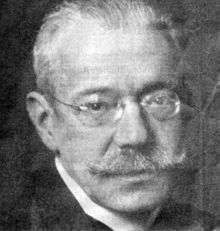Henri James Simon

(Henri) James Simon (17 September 1851 – 23 May 1932) was a German entrepreneur, art collector, philanthropist and patron of the arts during the Wilhelmine period. He donated most of his significant collections to the Berlin State Museums, including the famous Nefertiti bust.
Biography
Born in Berlin the son of a well-off Jewish cotton merchant, Simon attended the Berlinisches Gymnasium zum Grauen Kloster and received a six-month traineeship at Bradford, then a centre of textile manufacture, before he became a partner with his father in 1876. Though a reserved man, he played an influential role in the German society, especially by his participation at a regular roundtable with Emperor Wilhelm II. Simon and other invitees like Albert Ballin and Carl Fürstenberg as well as Emil and Walther Rathenau discussed economic life and tried to give the emperor an understanding of a Jewish perspective on social issues. Their close relationship with the erratic ruler was seen critical by Zionist contemporaries and the circle's participants were later mocked as the "Emperor's Jews" (Kaiserjuden) by Chaim Weizmann.[1]
Simon especially shared an interest for archaeology with Wilhelm II and in 1898 was one of the founders of the Deutsche Orient-Gesellschaft in collaboration with Wilhelm von Bode, and in 1901 the emperor himself assumed the auspices. In 1911 Simon provided the financing of Ludwig Borchardt's excavations at Pharaoh Akhenaten's city in Amarna, whereafter large parts of the found artefacts, which included the sculpted busts of Nefertiti and Tiye from a court sculptor's workshop outside the main tomb area, passed into his ownership after purchase. This purchase, which was according to a 1913 partition treaty with the Egyptian Département des antiquités under Gaston Maspero, is still disputed. He added the objects to his private collections at his villa on Tiergartenstraße No. 15a with the intention of creating a public collection. In his later years, he dedicated various parts of his collection as permanent loans for public display, at first to the Kaiser-Friedrich-Museum, which opened in 1904, and then with major donations to the Egyptian Museum, which followed in 1920. Both museums were severely damaged in WWII, but many of his original arrangements were resurrected by the partial restoration and new building developed by prize-winning architect David Chipperfield, who, after receiving the European Union Prize for Contemporary Architecture in 2011 for his work on the Neues Museum, won the commission for the new wing, which is called the James Simon Gallery.
James Simon died in Berlin and is buried at the Jewish cemetery on Schönhauser Allee in Prenzlauer Berg. Wilhelm II sent a wreath from his Dutch exile. Parts of his collection that were not donated to the state museums were auctioned.[2]
See also
External links
| Wikimedia Commons has media related to James Simon. |
- James Simon Foundation (in German)
- James Simon memorial
- "Das Herrenzimmer als Museumsraum" in Tagesspiegel, 18 October 2006 (in German)
References
- ↑ Chaim Weizmann: Trial and Error, 1949
- ↑ Miniaturen, Gemälde, Plastik, Kunstgewerbe und Textilien antiker Goldschmuck, Möbel, Bücher, by Rudolph Lepke's Kunst-Auctions-HausAuction, 1932 (catalog with sale amount list) on archive.org